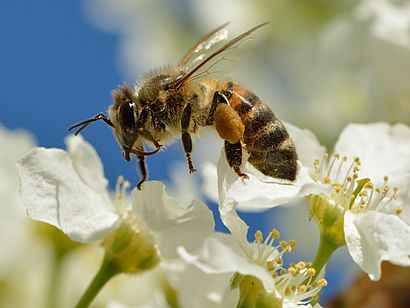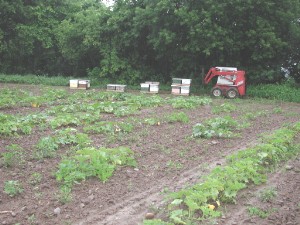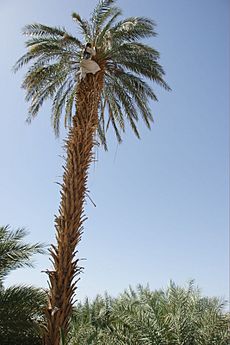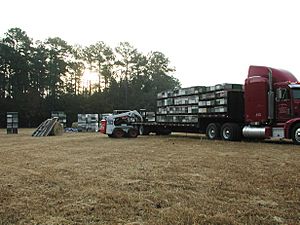Pollination management facts for kids

Honey bees are great at collecting pollen. They are often used to help pollinate crops. Look closely to see the light brown pollen in the pollen basket on its leg.
Pollination management is all about helping plants make fruits and seeds. Farmers use special methods to make sure their crops get pollinated well. This helps them grow more food and better quality food. It means understanding what each plant needs and how to use pollinators (like bees) or even people to help.
When you think of pollination, you might first think of the European honey bee. But there are many other ways to pollinate plants! Other insects, like the blue orchard bee, are even better at pollinating some fruit and nut trees. Local bumblebees are also very good for certain crops. Sometimes, people even do hand pollination, which is important for making new types of seeds or for plants grown in greenhouses. There are even machines that can help with pollination!
Contents
Why Pollinators Need Our Help
Sadly, the number of wild and managed pollinators is going down. This makes pollination management even more important for growing food. Many things cause this loss of pollinators. These include using pesticides incorrectly, losing natural areas where pollinators live, and changes in farming. When forests are cut down or wild areas are cleared, bees and other pollinators lose their homes and food. They also need a good variety of flowers to stay healthy.
Why Pollination Management is Important
Today, farms often have very large fields with only one type of crop. This is called a monoculture. While this can give pollinators a lot of food for a short time, it can also mean they don't have enough food at other times of the year. It can also expose them to pesticides. Most pollinators need different kinds of nectar source and pollen source throughout the growing season to stay strong.
Many crops have always needed help with pollination. These include apples, almonds, pears, some plums, cherry varieties, blueberries, cranberries, cucumbers, cantaloupe, watermelon, alfalfa seeds, and onion seeds. In the past, some crops relied on wild pollinators. But now, they often need managed pollination to grow enough food to sell.
Scientists have learned that while European honey bees visit many flowers, they might not be the most efficient for every crop. For example, the blue orchard bee focuses on just one type of tree. This makes it 100 times more efficient at pollinating that tree than a honey bee!
Some crops need a lot of pollinators to produce a good harvest. This is especially true in large fields of just one crop. This might be because the flowers aren't very attractive to bees, or because the natural pollinators are rare. Crops like alfalfa, cranberries, and kiwifruit often need many pollinators. This is sometimes called saturation pollination. Even if honey bees are not the most efficient, using many hives can make up for it. For example, the alfalfa leafcutter bee is much better at pollinating alfalfa.
Kiwifruit flowers don't even produce nectar, so honey bees don't like to visit them much. This means farmers need a huge number of honey bees, or they can use bumblebees. Bumblebees are much better at pollinating kiwifruit, even better than people doing it by hand!
How Many Hives Are Needed?
Farmers often need to bring in beehives to pollinate their crops. For example, about one honey bee hive per acre is usually enough for watermelons. In the 1950s, there were many wild bee nests and small farms had their own beehives. A farmer with 10 acres of watermelons would have had enough bees. But today, a farmer might grow 200 acres of watermelons. There are fewer wild bees and fewer beehives on farms. So, farmers often rent beehives to bring to their fields when the plants are flowering.
Different Types of Pollinators
Many different living things are used for managed pollination. These include honey bees, bumblebees, alfalfa leafcutter bees, and orchard mason bees. As we learn more, other species might be added to this list. People can also be pollinators! A gardener might hand pollinate their squash flowers. In the Middle East, farmers climb date palm trees to pollinate them by hand.
The number of managed beehives in the US has gone down a lot since the 1940s. At the same time, the amount of land used for crops that need bees has grown by over 300%! This means there aren't always enough beehives for farmers to rent. Farmers are looking for ways to attract more pollinators to their fields. By getting more honey bees and encouraging them to visit flowers, especially in the middle of big fields, farmers can get better harvests.
Planning for Better Pollination
Years ago, apple farmers sometimes planted huge areas with only one type of apple tree. This was a problem because apple trees need pollen from a different type of apple tree to make fruit. Now, growers know to plant different types of apple trees, like crab apples, among their main apple trees. They can also graft crab apple branches onto some trees. Another way is to place buckets of crab apple branches with flowers in the orchard. These branches provide the pollen needed for the main apple trees to produce fruit.
Pollination management combines knowledge from many different areas. It uses ideas from horticulture (growing plants), apiculture (raising bees), zoology (the study of animals, especially entomology which is the study of insects), ecology (how living things interact with their environment), and botany (the study of plants).




